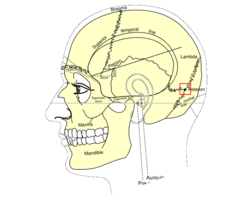- Asterion (anatomy)
-
Asterion (anatomy) Side view of head, showing surface relations of bones. (Asterion visible at center right.) Gray's subject #46 183 For other uses, see Asterion (disambiguation).The asterion is the point on the skull corresponding to the posterior end of the parietomastoid suture.
Location
In human anatomy, the asterion is a visible, so-called craniometric, point on the exposed skull, just behind the ear, where three cranial sutures meet:
- the lambdoid,
- parieto-mastoid, and
- occipito-mastoid sutures,
or where three cranial bones meet:
- Parietal bone,
- Occipital bone,
- and Mastoid portion of the Temporal bone.
In the adult, it lies 4 cm behind and 12 mm above the center of the entrance to the ear canal.
Clinical significance
Neurosurgeons use this point to orientate themselves, in order to plan safe entry into the skull for some operations.
Some surgeons call it the "Mercedes point", for its resemblance to the Mercedes-Benz logo.
Etymology
The asterion receives its name from Ancient Greek ἀστήρ ("aster"), meaning "star".
In Greek mythology, Asterion was one of the three river-gods. Poseidon, in a feud with them, made the rivers of these three gods run dry.
Bones of head and neck: compound structures of skull (TA A02.1.00.002–052, GA 2.178–199) Neurocranium Asterion · Pterion · Stephanion · Bregma · Lambda
Fossae: anterior cranial fossa · middle cranial fossa · posterior cranial fossa · cranial cavity
Base of skull
Fontanelles: anterior · posterior · sphenoidal · mastoidFacial skeleton Nasion · GonionBoth Categories:- Skull
- Head and neck
Wikimedia Foundation. 2010.

